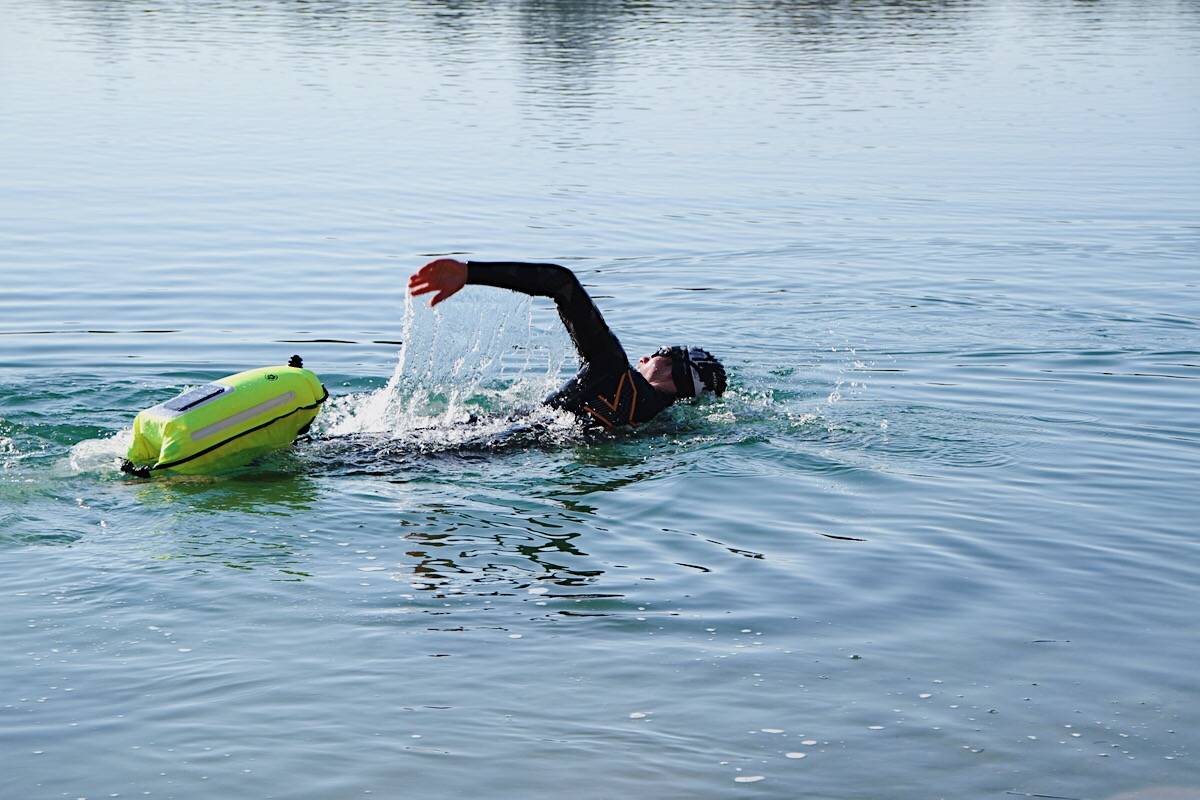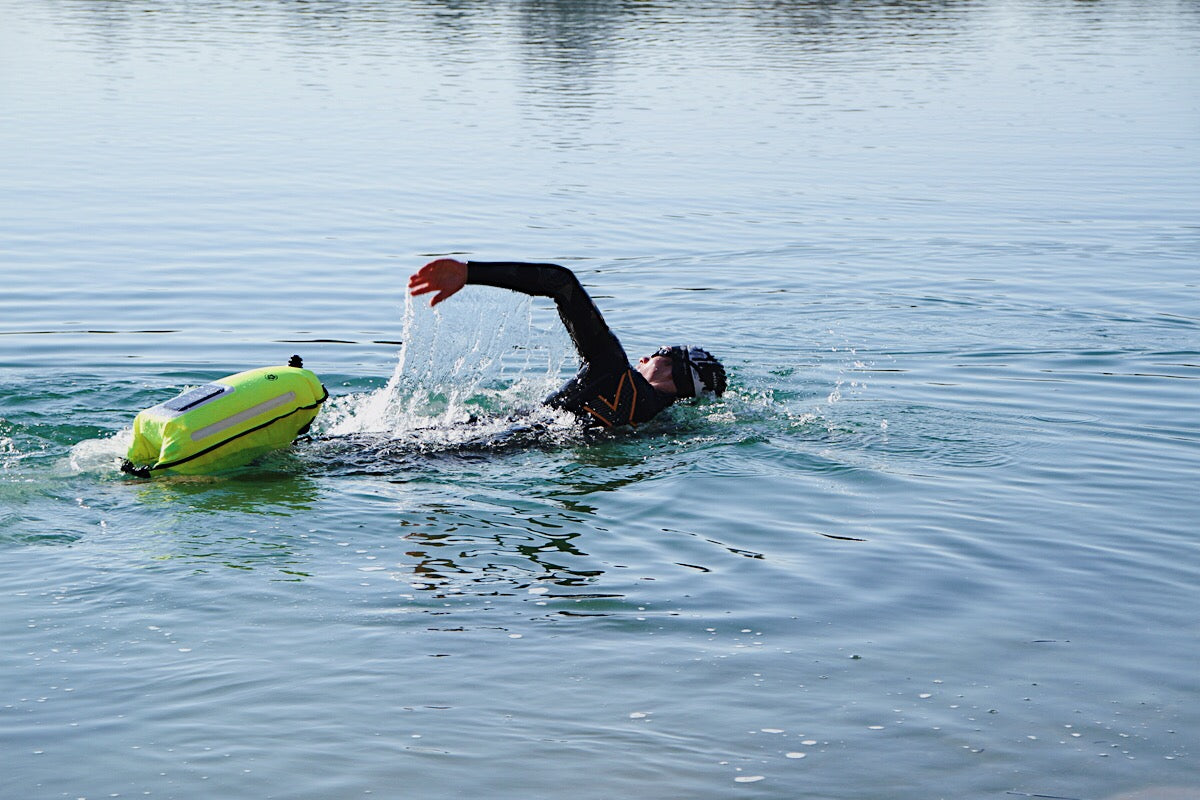The water temperatures in the lakes are rising every day, and going out into the open water - with a neoprene suit - is now a sensible training alternative for triathletes. However, swimming in a pool and swimming in open water are two different things. It is therefore important to prepare well for it. This applies to the material as well as your own ability and personal self-confidence. We have tips for going out into the open water.
Basically, every open body of water is different. Water temperature, currents, waves, visibility, subsoil and banks are probably the things that you should carefully explore or ask before you jump motivated into the water. Stop! Not yet! There are still a few things to do on the shore!
For the time being only with protection against the cold
Proper swimming training in the lake is unthinkable without a wetsuit. The Neo protects against cooling down and is a natural swimming aid thanks to its buoyancy properties. It also offers additional safety in open water, because with Neo you are always kept on the water surface and you can just "let yourself drift".
Currently it even makes sense to protect those parts of the body from the cold that are not covered by the wetsuit. This mainly affects the head, but hands and feet also lose temperature quickly.
Unrestricted view
Cloudy water and a lack of reference points from the usual swimming pool initially cause many athletes a certain degree of uncertainty in open water. Since we are so dependent on our visual sense for orientation, unrestricted vision is a very sensitive criterion in open water swimming. Important therefore: the choice of swimming goggles for the right perspective. Especially in open water, the goggles should fit well and reliably, not let in water, not fog up and allow a wide field of vision. Most triathletes rely on the so-called suction cup glasses with a large field of vision and curved lenses. Due to the curved fit and the soft seals, they usually lie around the eye socket and almost suck themselves on. On the one hand, this reliably protects the eyes from germs and other foreign bodies in the water. On the other hand, this ensures a large field of vision. In addition, the glasses offer UV protection and can also filter out bright sunlight thanks to their respective tint.
> Here you will find a selection of the most popular open water swimming goggles .
Here we go
Stop - don't be too hasty! Especially when the water temperatures are low or you have been in the sun beforehand, you should take it easy to get your body used to the water temperature.
In competitions, it has proven itself to swim thoroughly. Otherwise, the first few meters can quickly lead to shortness of breath. If that happens or you start to panic - no problem. A couple of chest pulls, take a deep breath and let's go. Basically, the same applies here: practice makes perfect. A few short training sessions in the open water will help to overcome the fear of the dark water.
Reference points & orientation
Orientation in open water is based on fixed buoys or fixed points on the shore. You should remember this before you step into the water for the first time. Once you're in the water, it's a lot harder to spot a buoy since your head is now at water level.
If the buoy is temporarily no longer visible (e.g. when there are waves), you can swim to this previously selected fixed point. This can be a tall tree, flagpole, building or similar that can be easily identified as an extension of the buoy on the shore.
Orientation is provided by a brief look ahead, which should flow as smoothly as possible into the crawl movement. It has proven useful to raise your head a little every five to six breaths during the breathing movement. This can also be practiced in training beforehand. Begin the exercise with alternating pieces of water polo crawl followed by normal crawl strokes. Slowly you build up the number of strokes that you swim water polo style and at some point you have a short period of time left in which you can orientate yourself forward.
3-way breathing yes or no?
In order to keep the inner compass as straight as possible, one hears the recommendation again and again: swim in the open water with triple breathing. Alternating breathing is intended to prevent drifting to one side. If it works? Try it. There is no golden rule here. Even the 3-way breathing does not guarantee that you will swim straight ahead. The changeover from double breathing could even prove to be disadvantageous at the beginning, since the lower breathing rate means that less oxygen is taken in overall. Lack of oxygen combined with an unfamiliar swimming area is not a good combination. So slowly approach the many variables in open water. Safety always comes first!
Practice creates masters
With every training session in the open water, confidence in your own abilities and in your material grows, the hand movements when putting on and taking off the wetsuit are second nature. For the entry into the open water training, the constant distance swimming is the most sensible variant in terms of training method: getting used to the open water, orientation, swimming with a wetsuit are in the foreground here. How long you swim doesn't matter at first - certainly also depends on the temperature and your level of performance.
The next step is to make the training in open water more variable and to set specific accents to compensate for the unusual swimming training in the pool, but also to practice the significantly higher dynamics in a competition scenario. You will get these tips in our next post.
Swimming buoy: safety, visibility & portability




















